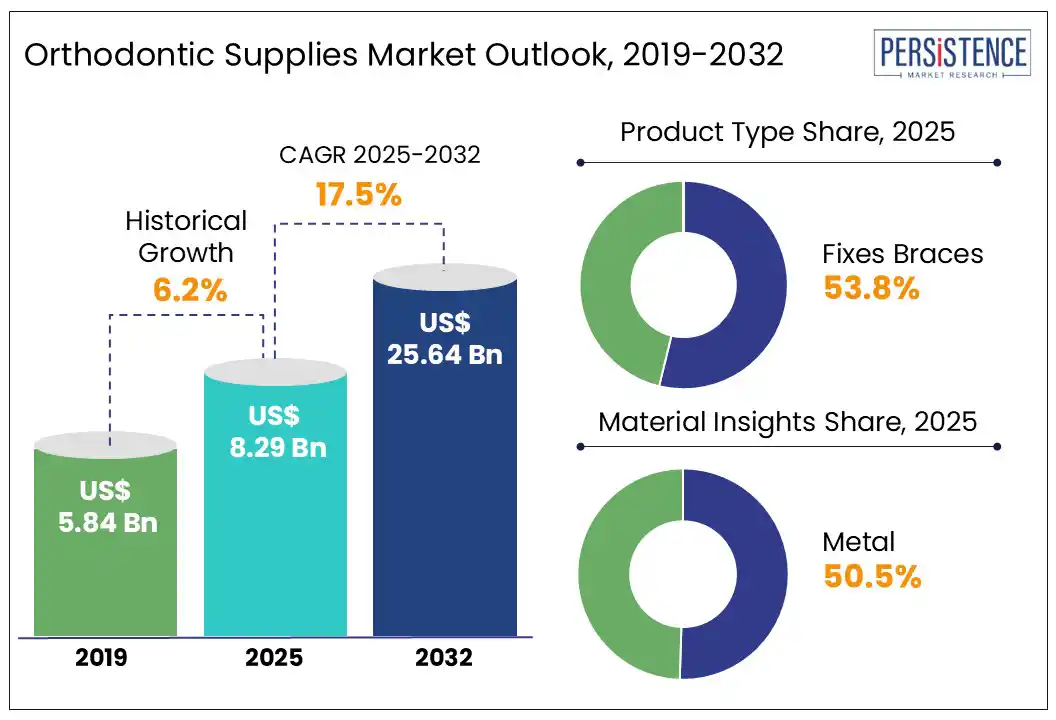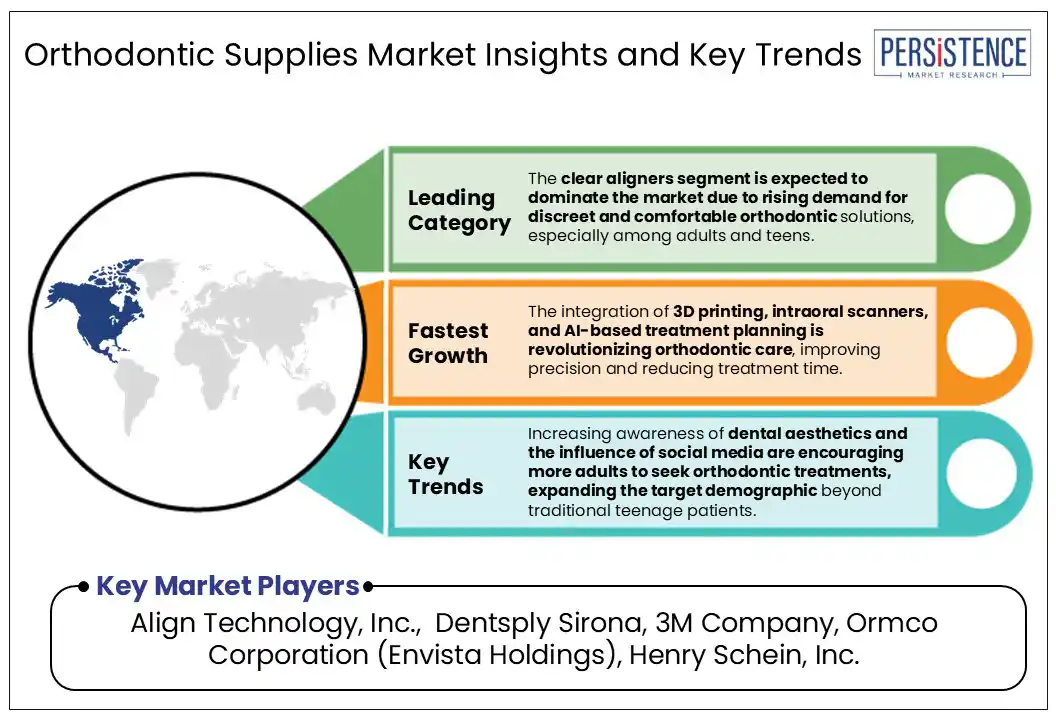ID: PMRREP35517| 200 Pages | 25 Jul 2025 | Format: PDF, Excel, PPT* | Healthcare

The global orthodontic supplies market size is likely to be valued at US$ 8.29 Bn in 2025 and is expected to reach US$ 25.64 Bn by 2032, growing at a CAGR of 17.5% during the forecast period 2025 – 2032. The global orthodontic supplies market is driven by rising awareness of dental aesthetics and increasing demand for advanced orthodontic treatment options. With a surge in cases of malocclusion and a growing preference for minimally invasive procedures, the market is expanding rapidly across both developed and emerging economies.
Technological innovations, including clear aligners, 3D imaging, and AI-based treatment planning, are transforming traditional orthodontic practices. The rise in adult orthodontic patients and the popularity of direct-to-consumer orthodontic solutions are reshaping market dynamics. This evolving landscape highlights significant opportunities in the dental care devices market and in the broader orthodontic treatment solutions industry.

Key Industry Highlights:
|
Market Attribute |
Key Insights |
|
Orthodontic Supplies Market Size (2025E) |
US$ 8.29 Bn |
|
Market Value Forecast (2032F) |
US$ 25.64 Bn |
|
Projected Growth (CAGR 2025 to 2032) |
17.5% |
|
Historical Market Growth (CAGR 2019 to 2024) |
6.2% |
The rising demand for invisible orthodontic treatment options is a major driver of market growth, particularly among adult and image-conscious patients. Clear aligners, which offer a discreet and comfortable alternative to traditional braces, are gaining popularity due to their aesthetic appeal and convenience. This trend is further supported by advancements in 3D orthodontic imaging technology, which enable precise treatment planning and faster turnaround times for custom appliances.
The increasing prevalence of malocclusion and jaw misalignment disorders is fueling the need for advanced orthodontic correction devices across both developed and emerging markets. The growing adoption of AI-powered dental diagnostics and treatment planning tools is enhancing clinical outcomes and reducing chair time, making orthodontic care more efficient and accessible. These innovations, combined with rising disposable incomes and greater awareness of oral health are expected to sustain strong market momentum through 2032.
Despite strong growth potential, the market faces challenges due to the high cost of orthodontic treatment procedures, which limits access for patients in low- and middle-income regions. The expense of advanced appliances such as clear aligners and 3D imaging systems often places them out of reach for a large segment of the population. The lack of comprehensive dental insurance coverage for orthodontic care in many countries further restricts patient adoption, especially among adults seeking elective treatments.
Another significant restraint is the limited availability of skilled orthodontic professionals, particularly in rural and underserved areas. This shortage affects the timely delivery of care and slows the adoption of digital orthodontic workflow systems, which require specialized training. Moreover, stringent regulatory requirements for product approvals and the complexity of orthodontic device manufacturing standards can delay market entry for new players, impacting innovation and competition.
Orthodontic manufacturers continue to explore growth avenues by investing in custom-fit clear aligner technology, which caters to the rising demand for personalized and aesthetic dental solutions. Companies leverage digital workflows and AI-based modeling to enhance treatment accuracy and reduce turnaround times. This innovation opens up new possibilities in the remote orthodontic treatment market, allowing providers to reach patients beyond traditional clinical settings.
Emerging economies present vast potential for expansion, especially as governments and private players invest in affordable orthodontic care infrastructure. With increasing awareness and high disposable incomes, regions including Asia Pacific and Latin America are witnessing a surge in the demand for digitally guided orthodontic appliances. Market players who offer scalable, cost-effective solutions and invest in orthodontic care outreach programs stand to gain a competitive edge in these high-growth areas.
The orthodontic supplies market is primarily segmented into fixed braces and removable braces. Fixed braces include brackets (conventional, self-ligating, and lingual), archwires, bands, buccal tubes, and anchorage appliances. Fixed braces lead the market with a 53.8% share, owing to their effectiveness in treating complex malocclusion cases and their widespread use among teens. Fixed braces are often the recommended choice by orthodontists for younger patients due to better compliance as they cannot be removed at will.
Innovations such as self-ligating brackets and lingual braces (placed on the inner side of teeth) have made fixed braces more comfortable and aesthetically appealing. These innovations have reduced treatment time, improved hygiene, and offer a more discreet experience compared to traditional models.
On the other hand, removable braces, comprising clear aligners and retainers, comprise the fastest-growing segment. Their popularity is driven by rising demand for aesthetic and flexible treatment options, especially among adults seeking discreet orthodontic solutions.
Orthodontic devices are manufactured using a variety of materials, each offering unique advantages in terms of durability, aesthetics, and patient comfort. Metal brackets remain the most widely used material, with 50.5% of the market share. Their dominance is attributed to their cost-effectiveness, strength, and reliability in treating a wide range of malocclusion cases. These brackets are especially popular among teens and in regions where affordability is a key factor.
Ceramic brackets, known for their aesthetic appeal, are gaining popularity among adult patients who prefer more discreet treatment options. Though more expensive than metal, they offer a discreet alternative without compromising on performance. The demand for ceramic materials is expected to grow steadily, particularly in North America and Europe, where adult orthodontic treatment is on the rise.

North America continues to dominate the orthodontic supplies market, holding a market share of 44.94%. This leadership is driven by widespread access to advanced dental care, high disposable income, and early adoption of technologies such as clear aligners and AI-based treatment planning.
The U.S. orthodontic supplies market is expected to hold approximately 39% of the global market share, with a high concentration of orthodontic specialists and leading companies such as Align Technology and Dentsply Sirona. The region also benefits from favorable insurance coverage and growing demand among adults for aesthetic treatments. Canada also contributes significantly, with a well-established dental care system and increasing adoption of digital orthodontic tools, particularly in urban centers such as Toronto and Vancouver.
Asia Pacific is the fastest-growing region, projected to expand at a CAGR exceeding 18% during the forecast period. This growth is fueled by rising awareness of dental health and expanding access to orthodontic care in countries including China, India, and South Korea.
In China, the market is booming due to a growing middle class and strong government support for healthcare modernization. India is witnessing rapid growth in urban areas, driven by rising dental tourism and the expansion of private dental chains.
South Korea, known for its advanced cosmetic dentistry sector, is also seeing increased demand for clear aligners among young adults. Local manufacturers and digital dental startups are entering the aligner market with competitively priced, tech-driven solutions. Companies such as denToGo (by Ray Corporation) and DIO Corporation are leveraging 3D printing and AI-based treatment planning to provide customized, fast-turnaround clear aligners at lower prices compared to imported brands. Local manufacturers are also entering the space with cost-effective solutions, making orthodontic care more accessible.
Europe holds a significant share of the global market, supported by a mature dental care system and strong demand for aesthetic treatments. Countries such as Germany, France, and the UK are key contributors, with high adoption of ceramic brackets and clear aligners among adult patients.
Germany leads in Europe, with a market share of 31%, in terms of orthodontic procedure volume, supported by a dense network of dental clinics and favorable reimbursement policies. France is investing in digital dentistry, while the UK is seeing a rise in adult orthodontic cases, particularly through private dental practices. The region benefits from favorable reimbursement policies and a strong focus on preventive dental care. Technological innovation and training programs continue to support steady market growth.
The global orthodontic supplies market remains fragmented, with a mix of global giants and regional players competing on innovation, pricing, and service quality. Companies increasingly adopt direct-to-consumer models and remote care platforms, reshaping traditional distribution channels and making orthodontic treatment more accessible. Key players in the global market include Align Technology, Inc., Dentsply Sirona, 3M Company, Ormco Corporation (Envista Holdings), Henry Schein, Inc., American Orthodontics, and GC Orthodontics.
The orthodontic supplies market is projected to reach US$ 8.29 Bn in sales by 2025, driven by rising demand for aesthetic and digitally guided orthodontic treatments.
By 2032, the orthodontic supplies market is expected to grow to US$ 25.64 Bn, reflecting strong expansion across both developed and emerging regions.
Key trends include the rise of clear aligner technology, adoption of AI-powered treatment planning, growth in adult orthodontic demand, and the expansion of direct-to-consumer orthodontic models.
The fixed braces segment leads the market, accounting for 53.8% of the global share in 2024, due to its effectiveness in treating complex malocclusions.
The market is expected to grow at a CAGR of 17.5% from 2025 to 2032, driven by technological innovation and increasing demand for aesthetic dental solutions.
Major players include Align Technology, Inc., Dentsply Sirona, 3M Company, Ormco Corporation (Envista Holdings), and Henry Schein, Inc.
|
Report Attribute |
Details |
|
Historical Data/Actuals |
2019 - 2024 |
|
Forecast Period |
2025 - 2032 |
|
Market Analysis |
Value: US$ Bn |
|
Geographical Coverage |
|
|
Segmental Coverage |
|
|
Competitive Analysis |
|
|
Report Highlights |
|
|
Customization and Pricing |
Available upon request |
By Product Type
By Material
By Age Group
By End-user
By Region
Delivery Timelines
For more information on this report and its delivery timelines please get in touch with our sales team.
About Author